Recent Articles
Popular Makes
Body Types
Ford Focus vs. Mazda Mazda3: Which Hot Hatch is Better?
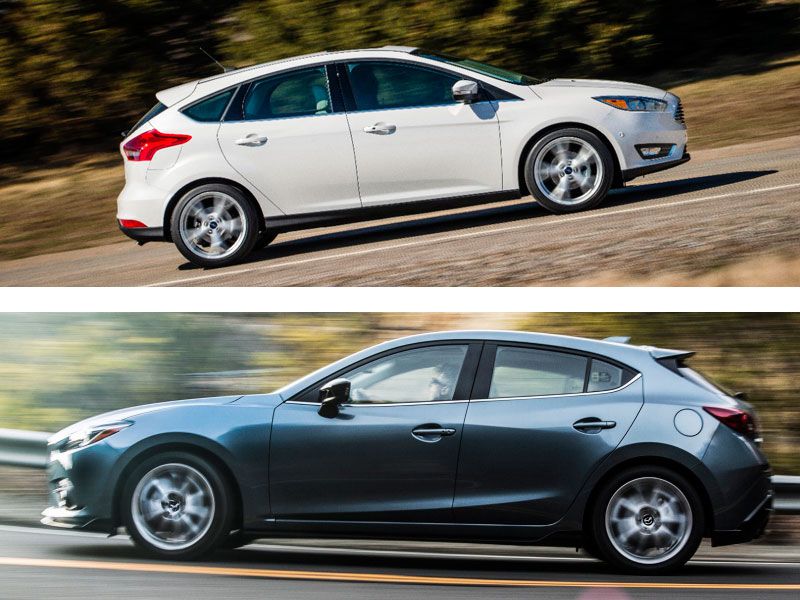
2016 Ford Focus vs 2016 Mazda Mazda3
Small-car partners in the past, the Blue Oval and the former Zoom-zoom brand now compete against each other in the compact segment with the 2016 Ford Focus and 2016 Mazda Mazda3, both of which follow the popular strategy of offering both hatchback and sedan body styles. The Focus is a bit older, however, as it rides on a platform that dates back to the 2012 model (and actually was used as the foundation for the previous-generation Mazda3). Ford’s entry was significantly refreshed just last year though. As for its rival, Mazda launched its current-gen car in for the 2014 selling season. There’s also a fairly large difference in their popularity: Despite being the most popular car in the Mazda lineup, the Mazda3 has been outsold by the Focus by more than 125 percent through the first quarter of the year.
On the other hand, buying a new car isn’t a popularity contest, and both the Focus and the Mazda3 offer some distinct advantages for customers, as you’ll discover below.
Focus vs. Mazda3: Pricing and Trim Levels
The lower price of admission here goes to the 2016 Ford Focus, as the S sedan model opens at $17,225 and the Mazda3 i Sport has an MSRP of $17,845. But that extra $620 spent on the Mazda includes a few premium touches that aren’t standard on the Focus sedan, like push-button start and a more upscale infotainment system with a bigger, full-color 7-inch touchscreen and six speakers to the four that are standard from the Ford. Needless to say, both also offer modern-day must-haves like standard air conditioning, steering-wheel-mounted audio controls, Bluetooth and power doors/windows/locks.
But it’s the Mazda3 with a more affordable hatchback, as Mazda’s five-door i Sport, at $18,545, compares to the Focus SE hatchback that starts at $19,105. At the upper end of the pricing spectrum, the range-topping Mazda3 s Grand Touring trim is “nicely equipped” at $24,745/$25,445 for the sedan/hatchback, versus $23,225/$23,775 for the Focus Titanium models.
Ford has a final advantage with two high-performance trims—the ST and RS—as well as Focus Electric EV.
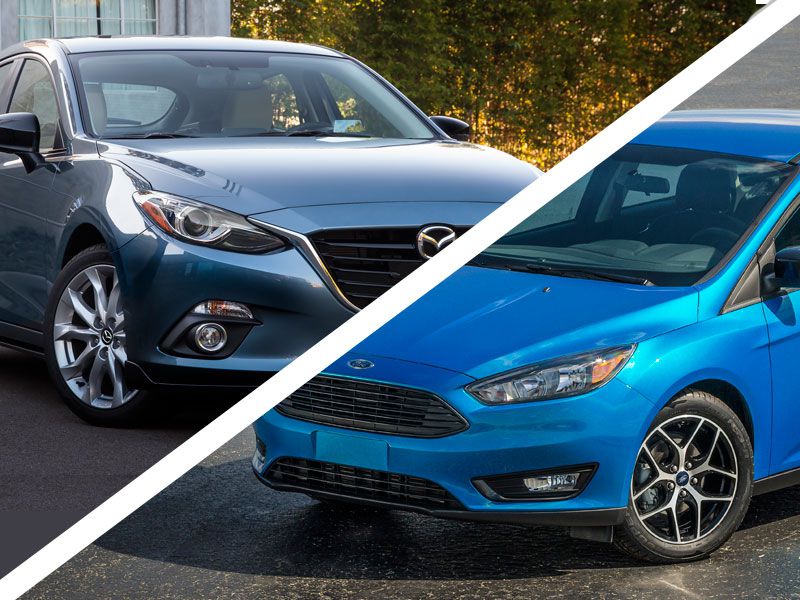
Focus vs. Mazda3: Powertrains, Performance and Efficiency
Both competitors can serve up impressive powertrain technologies, and if Ford has a wider selection, with higher overall marks for engine output and fuel economy, Mazda makes up for it with a noticeably more efficient standard engine. The Mazda3’s standard 2.0-liter, four-cylinder Skyactiv engine produces 155 horsepower, 150 lb.-ft of torque and an EPA line of 29 mpg city/41 mpg highway/33 mpg combined with its standard six-speed manual; the available six-speed auto enables a line of 30/41/34. The Focus’ standard four-cylinder tops out at 26/36/30 with a manual gearbox and 26/38/30 with an automatic. Output in either case is 160 horsepower and 146 lb.-ft. of torque.
Mazda does provide a 2.5-liter premium four-cylinder engine for the Mazda3, delivering 184 horsepower and 185 lb.-ft. of torque as well as an EPA high point of 40 mpg highway with the brand’s i-ELOOP regenerative braking system. But Ford has four other powertrains for the Focus:
- The three-cylinder, 1.0-liter EcoBoost is good for 123 horsepower, 125 lb.-ft. of torque and EPA ratings of 30/42/35
- A 2.0-liter EcoBoost in the Focus ST that can unleash 252 horsepower and 270 lb.-ft. of torque
- In the ferocious Focus RS, a 2.3-liter EcoBoost worth 350 horses and 350 lb.-ft. of twisting power
- The Focus Electric’s EV propulsion system that enables a 76-mile driving range on a single charge
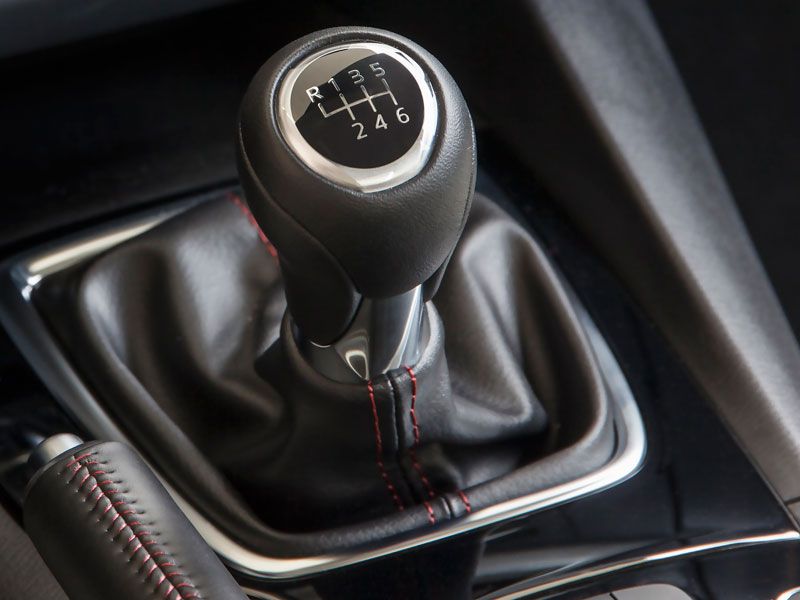
Focus vs. Mazda3: Feature Highlights
The 2016 Ford Focus and 2016 Mazda Mazda3 each supply the typical range of features expected in the segment, but as with engines, the Focus has a bit more to offer overall, although the Mazda3 has a slightly higher level of standard content at a given trim level. For example, as mentioned, the Mazda3’s standard infotainment setup, a Mazda Connect system, has a full 7-inch touchscreen. So the Focus ups the ante with an available 8-incher for its next-gen Sync 3 technology. Then, Mazda showcases navigation and premium audio from Bose for the $22,545 i Grand Touring sedan, with nine speakers; Ford’s fanciest audio system, from Sony, has 10 speakers on the Titanium sedan, which has an MSRP of $23,225 with navigation. And here’s one more: Both offer heated front seats with a power-adjustable driver’s chair, but the Mazda3 has a six-way adjustment to the Focus’ eight-way range of motion.
The two compact competitors additionally have some brand-exclusives to boast about. Mazda’s infotainment functions can be controlled by a handy Commander control interface that’s located just behind the gear-shift selector, for easy access. Meanwhile, Ford touts the MyKey teen-driver technologies, for monitoring the road habits of younger drivers, along with a capless fuel-fill setup and the Blue Oval’s hallmark SecuriCode keypad entry system.
(The Focus ST and RS also feature hi-po content, including performance-oriented all-wheel drive, that has no direct counterpart at Mazda.)
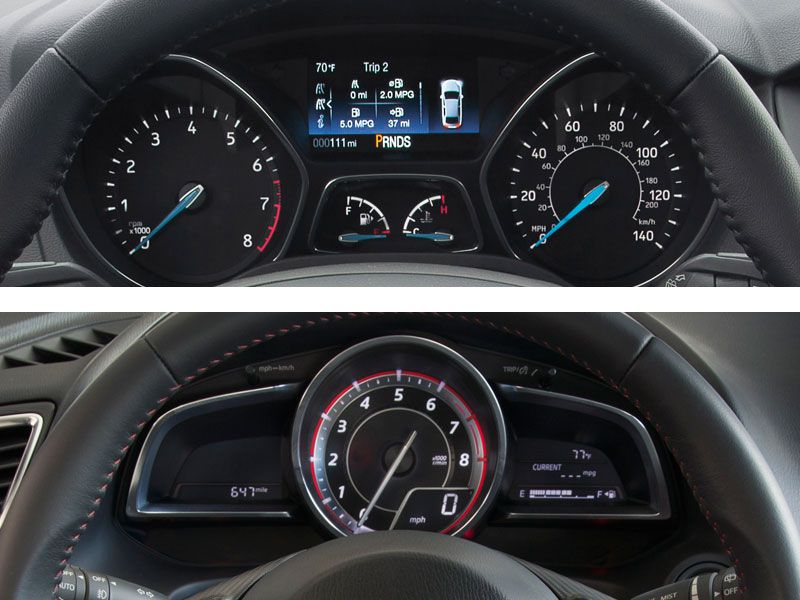
Focus vs. Mazda3: Exterior Design and Lighting
Compact cars can look awkward in sedan configurations, since it seems hard to get the trunk proportions right when working in smaller dimensions, yet the 2016 Mazda Mazda3 and 2016 Ford Focus are fairly successful in the four-door body styles. For Mazda, that means a swoopy appearance they call “Soul of Motion,” with particularly curvy flanks, while Ford designers rely on a cleaner look for the Focus. That said, the five-door hatches seem more organic to the eyes of Autobytel’s experts, with the Mazda3’s flowing lines stretching and lowering its stance, and the Focus taking a wider-looking, yet also firmly planted, footing. In terms of real-world measurements, the Mazda3 is a few inches longer in both sedan and hatchback formats, reaching 180.3 and 175.6 inches, respectively, and riding on a correspondingly longer wheelbase.
Both also brighten up their exteriors with detailed lighting cues, including LED daytime running lamps/signature lighting, which the Mazda3 complements with available bi-xenon headlights; the Focus features halogens.
Of course, right along with the trend in other areas, it’s the Ford that further stretches its design offerings with 12 wheel choices, 14 exterior colors, and dedicated style packages for the ST, RS and Electric.
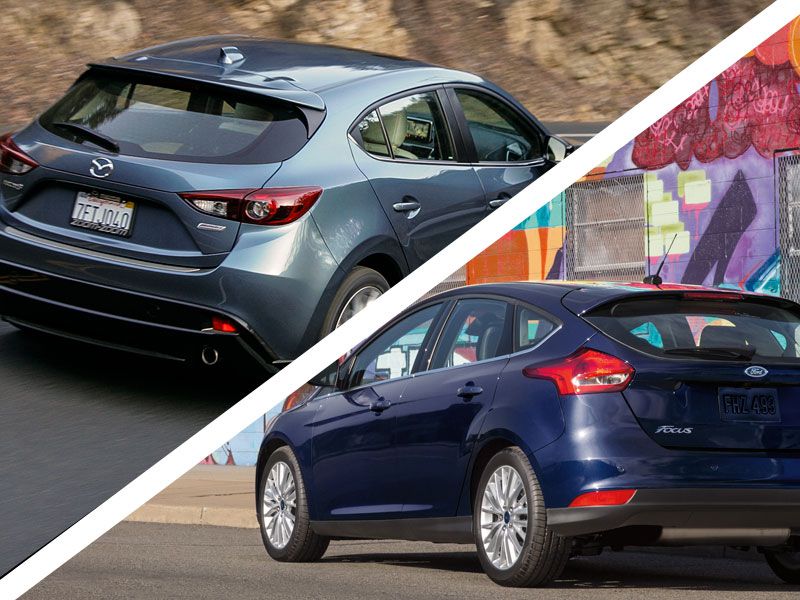
Focus vs. Mazda3: Interior Design and Capacities
Putting aside the enthusiast-friendly cabins found only in the Focus ST and RS, the most obvious difference in interior design between the 2016 Mazda Mazda3 and 2016 Ford Focus may be the way the brands dealt with their infotainment displays. In the Focus, the touchscreen is integrated within the center stack in the traditional manner and capped over with a “brow” that echoes that over the instrument panel. But for the Mazda3—much like for the Mercedes-Benz C-Class and many Audi models—the screen looks like a standalone piece that has been stuck on top of the dash, just above the center climate vents. It’s the one thing that stands out from the otherwise less-fussy design from Mazda.
The Mazda’s larger exterior has the expected effect inside the cabin, providing owners with 7 percent more passenger volume—much of it in width and, especially, rear-seat legroom. Consider:
- Focus has more rear-seat headroom (.4 inches) and front-seat legroom (.9 inches)
- Mazda leads for front-seat headroom (+.3 inches), front/rear shoulder room (+.6 inches/+1.8 inches), front/rear hiproom (+1.6 inches/+.7 inches), and rear-seat legroom (+2.6 inches)
Perhaps surprisingly, the Focus sedan’s 13.2 cubic feet of trunk room is .8 more than supplied by the Mazda3 four-door, and there’s 2.1 extra cubic feet of cargo capacity behind the Focus hatchback’s rear seats (20.2 vs. 23.3). Rear seats folded, the Mazda hatch has 47.1 cubic feet of storage space to the Ford’s 43.9.
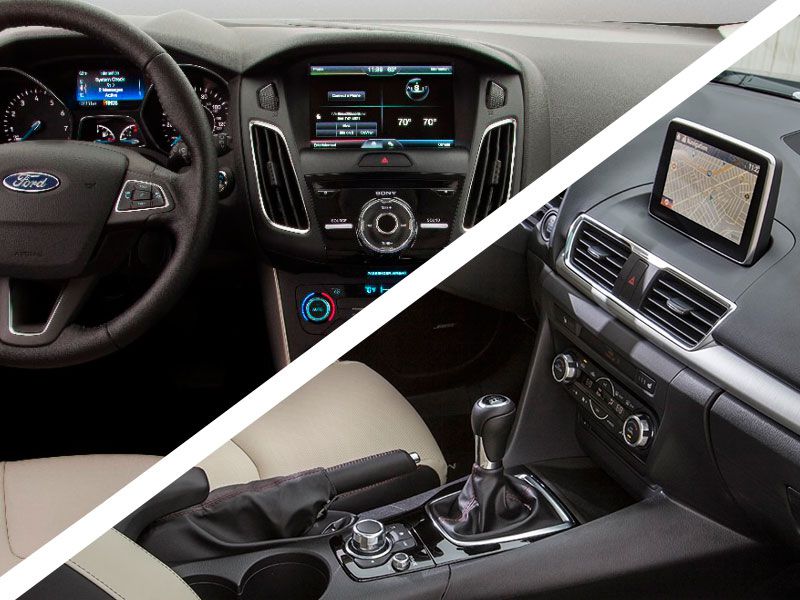
Focus vs. Mazda3: Safety Ratings and Technology
The 2016 Mazda Mazda3 and 2016 Ford Focus both have 5-star Overall Safety Scores from NHTSA, bolstered by 5-star grades for frontal- and side-crash scenarios and 4-star ratings in rollover testing. The situation is a little different with the IIHS, which requires “good” grades in all crashworthiness tests and at least a basic level of front crash-prevention technology to earn a Top Safety Pick recognition. The Focus received an “acceptable” rating in the former and doesn’t supply any of the latter. The Mazda3 garners the full Top Safety Pick+ honor, with top ratings for crashworthiness plus an “advanced” grade for frontal crash-prevention tech.
Running down the industry’s favorite driver-assistance measures, both cars provide standard rearview cameras and available blind-spot monitoring, lane keeping and cross-traffic alert, and the Focus is the sole selection with active parking assistance and a reverse-sensing system.
The Mazda3, backed by the i-Activsense safety bundle, adds available adaptive cruise control, forward obstruction warning and a low-speed automatic forward-braking system.
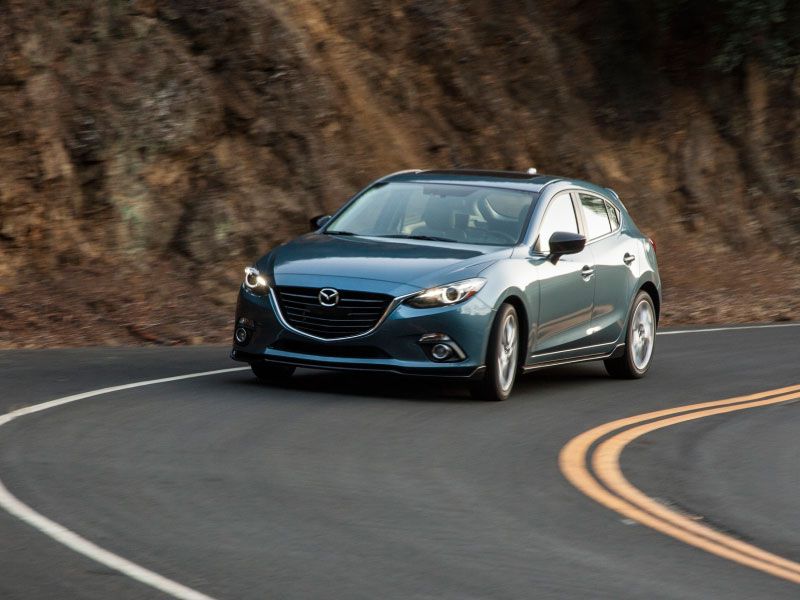
Focus vs. Mazda3: Final Thoughts
The 2016 Mazda Mazda3 and 2016 Ford Focus are two strong choices in the compact-car segment, and although the Ford product far outsells its rival, it’s probably no coincidence that the main advantage of the Focus is its ability to reach a wider range of customers. Remember, Ford can deliver high-performance ST and RS Foci, and an all-electric version, none of which have answers at Mazda. Ford also brackets the Mazda3 with less and more premium Focus trims, to reach more price points.
The Mazda more than matches up with the Ford at the middle of their lineups, and the deciding factor may come down to where you fall in the affordability range—and what you think of the Mazda3’s Top Safety Pick+ achievement.
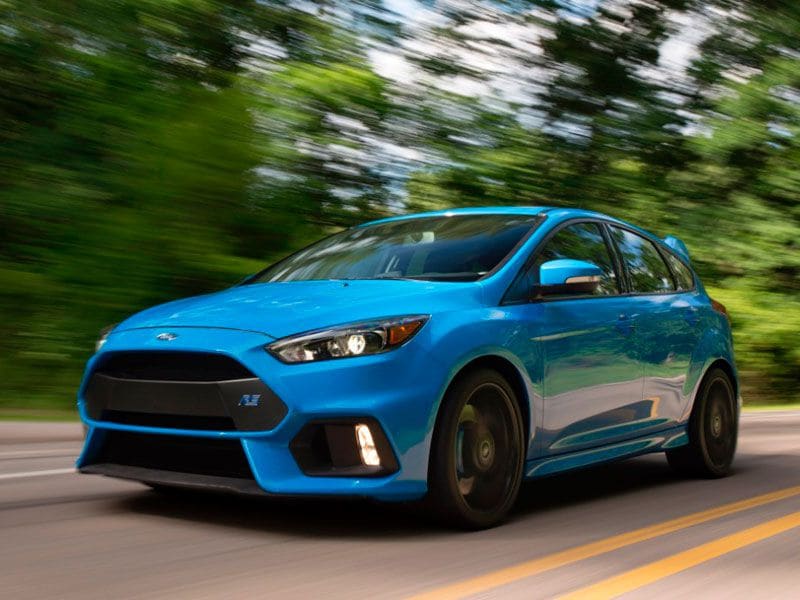
Photo by Ford